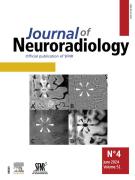Transient modifications of the olfactory bulb on MR follow-up of COVID-19 patients with related olfactory dysfunction - 18/06/22
 , Lea Distinguin b, 1, Anaelle Chetrit a, Dominique Safa a, Stephane Hans b, Robert Carlier a, Jerome R. Lechien b, c, d, 2, Myriam Edjlali a, e, 2
, Lea Distinguin b, 1, Anaelle Chetrit a, Dominique Safa a, Stephane Hans b, Robert Carlier a, Jerome R. Lechien b, c, d, 2, Myriam Edjlali a, e, 2ABSTRACT |
Background |
: Olfactory dysfunction (OD) has been reported with a high prevalence on mild to moderate COVID-19 patients. Previous reports suggest that volume and signal intensity of olfactory bulbs (OB) have been reported as abnormal on acute phase of COVID-19 anosmia, but a prospective MRI and clinical follow-up study of COVID-19 patients presenting with OD was missing, aiming at understanding the modification of OB during patients'follow-up.
Methods |
: A prospective multicenter study was conducted including 11 COVID-19 patients with OD. Patients underwent MRI and psychophysical olfactory assessments at baseline and 6-month post-COVID-19. T2 FLAIR-Signal intensity ratio (SIR) was measured between the average signal of the OB and the average signal of white matter. OB volumes and obstruction of olfactory clefts (OC) were evaluated at both evaluation times.
Results |
: The psychophysical evaluations demonstrated a 6-month recovery in 10/11 patients (90.9%). The mean values of OB-SIR significantly decreased from baseline (1.66±0.24) to 6-month follow-up (1.35±0.27), reporting a mean variation of -17.82±15.20 % (p<0.001).
The mean values of OB volumes significantly decreased from baseline (49.22±10.46 mm3) to 6-month follow-up (43.70±9.88 mm3), (p=0.006).
Conclusion |
: Patients with demonstrated anosmia reported abnormalities in OB imaging that may be objectively evaluated with the measurement of SIR and OB volumes. SIR and OB volumes significantly normalized when patient recovered smell. This supports the underlying mechanism of a transient inflammation of the OB as a cause of Olfactory Dysfunction in COVID-19 patients.
Le texte complet de cet article est disponible en PDF.Graphical abstract |
Highlights |
• | COVID-19 patients with demonstrated anosmia reported abnormalities in olfactory bulb (OB) imaging. |
• | OBs were objectively evaluated with the measurement of T2 signal intensity ratio and volume. |
• | OB MRI showed initial increase in T2 signal and in volume, with a normalization during follow-up. |
• | The MR normalization was consecutive to smell recovery for patients. |
Keywords : Anosmia, COVID-19, SARS-CoV-2, Magnetic resonance imaging, Olfaction disorders
Abbreviations : COVID-19, OB, OC, OD, SARS-CoV-2, SIR
Plan
Vol 49 - N° 4
P. 329-332 - juin 2022 Retour au numéroBienvenue sur EM-consulte, la référence des professionnels de santé.

